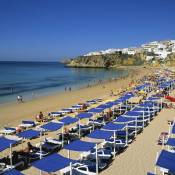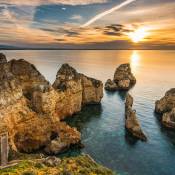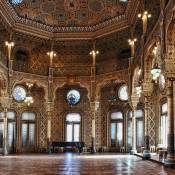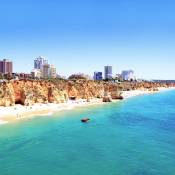Museums and Galleries
The Museu Municipal de Óbidos, or Óbidos Municipal Museum, can be found occupying the rooms of the town's old town hall on Rua Direita.
It's collection primarily comprises statues brought to life between the fifteenth and seventeenth centuries, alongside artworks by Josefa de Óbidos. A rare example of a known female religious artist, she died in the town in 1684. Many of her works that are not should here have found there way to the Museu Nacional de Arte Antiga in Lisbon.
Beyond its sacred artefacts, the museum also exhibits baroque furniture, and smaller finds that stretch...

The Douro Museum should be the first port of call for anyone interested in the culture and heritage of the Douro valley. Located in the region's unofficial capital, Peso da Régua, the museum occupies the Casa da Companhia Velho, a former wine warehouse on the riverfront.
Exhibits range from the historic to the modern. They cover not just the development of wine and port in the region in the permanent exhibition, but also its geography and a full insight into how people used to live in days gone by.
Should you need some further convincing, tickets (adult tickets cost around €6...
Perfectly located for anyone touring the sights of central Vila do Conde, this museum of traditional lace making isn't just a building full of examples of Portuguese and international lace. It is also a working art school teaching this traditional form of handicrafts to students from all over the world.
The delicate materials provide a great accompaniment to the building in which they are housed, which is a typical city mansion for the region. The permanent collection includes an important array of finished items of clothing, in addition to implements and examples of modern lace...

Vila do Conde has been one of Portugal's foremost ship-building ports since the 1200s, when a powerful navy was arguably even more important than it is today. This heritage eventually led to Portuguese sailors making some of the most important discoveries of the era, marking out routes to Brazil, Africa and India. This intriguing history is told through the three main exhibition spaces within the Museum of Naval Construction, also known as the Alfândega Régia.
Situated on the banks of the River Ave in a former customs house, the museum is a treasure trove of objects that together...

The Casa do Corpo Santo (House of the Holy Body) is also known as the Museum of the Baroque. Situated close to one of the remaining sections of city wall that have protected Setúbal from attack for centuries, its own exterior perimeter wall and simple marble name plate give little away about what you might find inside.
This includes several relics from when the Casa do Corpo Santo was first built in the early 1700s, alongside beautiful blue and white tiling decoration added roughly 150 years later which lines many of the rooms from the floors to chest height.
The selection of...
A short wander north from the harbour, Setúbal's Museum of Archaeology and Ethnography (Museu de Arqueologia e Etnografia) is located on the busy Avenida Luisa Todi thoroughfare.
The museums archaeological displays are focussed around the Roman origins of the city 1500 years ago. Its impressive ethnographic collection instead helps to unravel the local customs and culture of the region, from farming to spinning and other handicrafts.
The museum is open Tuesday to Saturday (with a gap for lunch around midday). Admission is free.

With its dark blue plasterwork and contrasting pale stonework windows, it's not hard to spot Setúbal's Casa da Baía, or House of the Bay. Only a short walk from the town's main square, the Praça de Bocage, it was built in the aftermath of the devastating Lisbon earthquake of 1755 as a home for orphans and widows. Many were buried in the cloister grounds after their deaths.
The ambience that surrounds the Casa da Baía is a much happier one today. The building serves as an exhibition space for people to learn about the natural environment (with information in both Portuguese and...

Braga's Raio Palace, or Palácio do Raio, was built in the 1750s as the private home of João Duarte de Faria. Although Faria had made considerable wealth as a merchant, he was also a knight of the Military Order of Christ - better known as the Knights Templar.
The Raio Palace was constructed in the late Baroque style by André Soares, an architect who had already made a name for himself as a leading champion of the northern baroque school. His other works within the city include the town hall, Church of Congregados, and Arco da Porta...
While its name might not give much away, the Museu Municipal de Peniche (or Peniche Municipal Museum) is as dramatic as they come. For one thing, the museum's galleries occupy the ancient chambers of Peniche Fortress, which has stood on the rocky foreshore of the peninsula since the 1500s. For another, it spans the history of Portugal from the 40,000-year-old Neolithic finds of Furninha Caves, through boatmaking and traditional lace weaving, to the modern era.
Also known as the "Museum of National Resistance and Freedom" exhibits therefore include the visitors' room from the time...

The Portuguese Toy Museum (Museu do Brinquedo Português) is housed in the Casa do Arnado and its annexes, directly across the medieval bridge from Ponte de Lima. The permanent exhibition takes us on a journey through the Portuguese toy manufacturers, from the late 19th century until the 1980s.
On the first floor, the arrangement for decades allows a notion of manufacturers, manufacturing techniques, raw materials and geographical distribution of Portuguese industries. Visit tinplate bells, wooden beach buckets, pulp dolls, vans, boats, trains, tricycles and pedal cars. The...




 Albufeira
Albufeira





 Cascais
Cascais


